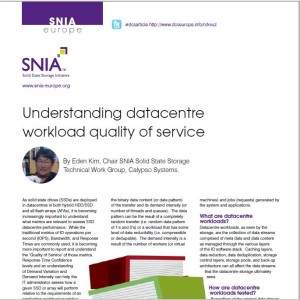By Marty Foltyn
As solid state drives (SSDs) are deployed in datacenters around the world in both hybrid HDD/SSD and all flash arrays (AFAs), it is becoming increasingly important to understand what metrics are relevant to assess SSD datacenter performance. While the traditional metrics of IO operations per second (IOPS), Bandwidth, and Response Times are commonly used, it is becoming more important to report and understand the ‘Quality of Service’ of those metrics.
 Eden Kim, Chair of the SNIA Solid State Storage Technical Working Group, has recently authored an article on Understanding Data Center Workloads. In it, he defines workloads and specifically data center workloads, describes how they are tested, and shows how to measure workloads for performance analysis. Industry standard test methodologies that ensure fair and accurate testing of SSDs both at the device and system level are described, along with how to use them on a reference test platform, Eden also describes in depth Response Time Confidence levels and how an understanding of Demand Variation and Demand Intensity can help the IT administrator assess how a given SSD or array will perform relative to the requirements of an application workload or relative to a specific Response Time Ceiling thus helping in the overall system optimization, design, and deployment.
Eden Kim, Chair of the SNIA Solid State Storage Technical Working Group, has recently authored an article on Understanding Data Center Workloads. In it, he defines workloads and specifically data center workloads, describes how they are tested, and shows how to measure workloads for performance analysis. Industry standard test methodologies that ensure fair and accurate testing of SSDs both at the device and system level are described, along with how to use them on a reference test platform, Eden also describes in depth Response Time Confidence levels and how an understanding of Demand Variation and Demand Intensity can help the IT administrator assess how a given SSD or array will perform relative to the requirements of an application workload or relative to a specific Response Time Ceiling thus helping in the overall system optimization, design, and deployment.
Read Eden’s full article on the SNIA Solid State Storage Education page at http://www.snia.org/forums/sssi/knowledge/educationBy. Scroll down to “Performance” to find this and a whole range of white papers, tech notes, webcasts, and presentations on this important Solid State Storage topic.